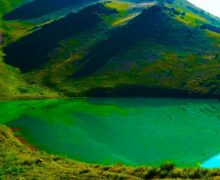South African Wine Adventures

The 17th century marks the beginning of the wine industry in South Africa. The year was 1655 when the first grapes were planted by a Dutch settler. The first bottle was produced in Cape Town by Jan van Riebeeck, the Dutch station manager for the Dutch East India Company who arrived in 1652 to establish a refreshment station – supplying fresh produce to its merchant fleet at the Cape of Good Hope. Why produce wines? It appears that the intent of his venture was to keep scurvy away from the sailors during their voyages along the spice routes to India and the East. His first harvest was February 2, 1659, 7 years after landing (1652).
Simon van de Stel followed Riebeeck, and was able to improve the quality of the viticulture and increased the number of acres, establishing the Constantia wine estate. Upon his death, the winery went fallow until 1778, when it was purchased by Hendrik Cloete.
Even in the 18th century, the wines of South Africa were popular and European aristocrats preferred these wines and it was a favorite of Napoleon Bonaparte. The sweet wines from Constantia were considered among the world’s best in the 18th and 19th centuries.
Because of distance, political and social issues, growers stopped making wine, turning the soil over to orchards and alfalfa fields to feed the growing ostrich feather industry. As time and economics changed, growers started to replant grapevines, selecting high-yielding grapes (i.e., Consault) and by the early 1900s more than 80 million vines had been replanted which, unfortunately, created a “wine lake” -producers, focusing on quantity over quality, were making unsaleable wine and poured it into local rivers and streams.
There definitely was an imbalance between supply and demand, creating depressed prices. This critical situation prompted the government to form Kooperatieve Wiibouwers Vereiging Van Zuid-Afrika Bpkt (KWV) in 1918. The organization was tasked with setting policies and prices for the entire South African wine industry. To deal with the wine glut, the KWV restricted yields and set minimum prices, encouraging production of brands and fortified wines.
20th Century Mindful
In the 1990s, Apartheid ended and the world’s export markets opened for the wines from South Africa. Producers adopted new viticulture, winemaking techniques and technology, focusing on Shiraz, Cabernet Sauvignon and Chardonnay. The reorganization of KWV into a private enterprise sparked innovation and improvement in quality, forcing vineyard owners and wineries to become competitive and the focus of wine making shifted from quantity to quality. By 2003, 70 percent of the grapes harvested reached the consumer market as wine.
Currently, 93,021 ha of vines produce wine grapes and are under cultivation in South Africa over an area approximately 498 miles in length. The major vineyards are centered near Constantia, Paarl, Stellenbosch and Worcester. There are approximately 60 appellations in the Wine of Origin (WO) system that was started in 1973 with a hierarchy of designated production regions, districts and wards.
WO wines must contain:
- Grapes from the specific area of origin
- Single vineyards must come from a defined area of less than 5 ha
- Estate Wine may come from adjacent farms if they are farmed together and wine is produced on the site
- A ward is an area with a distinctive soil type or climate and approximately equivalent to a European appellation
Sustainable Wine Growing
Over 95 percent of the South African wine industry follows sustainable wine-growing and winemaking principles. For the 2010 vintage, the country introduced “The Seal,” a label that certifies that a wine has been produced sustainably, that it was bottled within the nation’s borders and it is 100 percent South African.
Going for the Grapes
In 1925, Abraham Perold, the first viticulture professor at Stellenbosch University, cross pollinated Pinot Noir with Hermitage to develop Pinotage, a brand-new grape variety. Pinotage did not appear as a wine until 1959 and it presents the cherry fruit of Pinot Noir with the earthiness of a Rhone wine.
In 1946, Distell, one of the largest South African wine producers, opened the first modern research and quality control center and in 1955, the Viticultural and Oenological Research Institute was started. New research and technology helped protect local production from diseases as phylloxera, that had destroyed millions of Cape vines in 1885.
Currently white varieties make up over 55 percent of the plantings for wine, with Chenin Blanc responsible for 18.6 percent of the total. Red-wine varieties account for 44.8 percent of the national vineyards. The most widely planted red varieties are Cabernet Sauvignon, (11 percent), Shiraz (10.3 percent), Pinotage, (7.4 percent) and Merlot, (5.8 percent).
Climate
The moderate climate of the Western Cape’s peninsula region offers ideal terroir for grape cultivation and the fertile soil supports agriculture in the southern coastal areas that are influenced by the Atlantic and Indian Oceans. The Mediterranean climate delivers intense sunlight and dry heat. Winters are cold and wet with opportunities for snow at higher elevations. Springtime frost is rare as there is usually a warm growing season between November and April. In many regions’ irrigation is essential.
Economics
Wine production in South Africa ranks 9th in world wine production, producing 3.4 percent of the world’s wine (2018). Over 300,000 people are employed directly and indirectly in the wine industry (2015), including farmer labor, packaging, retailing and wine tourism. Over US$2.45 billion GDP is contributed to the wine industry in the regional economy, with about US$1.334 billion remaining in the Western Cape, benefiting the residents.
Exports of still (non-fortified) packaged wines (2018), reached 163.9 million liters, a decrease of 3.8 percent on the previous year. Red wine exports declined by 8.7 percent with total exports decreasing by 6.3 percent to 420.2 liters in 2018. Major exports are to USA, Germany, France, and The Netherlands.
Wines. My Suggestions
At a recent wine trade event in Manhattan, I had the good fortune to be introduced to a few incredibly unique Chardonnay and Pinot Noir South African wines. My personal favorites follow:
2017 Vergelegen Reserve. 100 percent Chardonnay. Stellenbosch
Stellenbosch was settled on the banks of the Eerste River in 1679 and named for the Governor, Simon van der Stel. It is the second oldest settlement, following Cape Town. Stellenbosch is an incredibly important wine producing region in South Africa and Cabernet Sauvignon is the region’s most widely planted grape variety. Almost 1/5 of all vines planted in South Africa are located here.
The area is located 25 miles from Cape Town. The terrain permits for variation in wine styles and the mesoclimates are suitable for the cultivation of grape varieties. Granite and sandstone dominate the terroir in the Stellenbosch area. The high-clay content suggests that the terroir is free draining; however, there is excellent water-retention.
The winter provides rainfall and permits growers to keep irrigation to a minimum. The weather is hot and dry with maritime influence from False Bay in the south. Southeasterly breezes temper the vineyards in the afternoons, following hot morning sun. The white wine varieties are planted closer to the ocean where the cool breezes are more prevalent.
Vergelegen (situated far away) was founded in 1700 and has been owned by explorers and visionaries who have shaped this world-class Estate. Today it is known for handcrafted wines.
Notes.
Estate grown grapes are selected from 3 vineyards: Rooiland 12/13 and the super vineyard Lower Schaapenberg. Grapes are whole-bunch pressed with no skin contact. The juice, with some clarification, is racked into 35 percent new French oak barrels (Francois Frere, Dargaud & Jaegle), and 50 percent second-fill and third-fill barrels for alcoholic fermentation. Spontaneous onset of fermentation, and after 7 days, the barrels are inoculated with a pure culture yeast strain followed by fermentation for 15 days to complete the process. Once the sugar is fermented, all 43 barrels are topped up. Only 1/3 of the barrels are allowed to complete malolactic fermentation to retain optimum acidity/freshness. The young wine is left on the gross lees for 10 months with regular battonage, then stabilized and bottled.
The first view is of a very light golden lemon/green hue, the nose is happy with a terrific aroma of earth, graphite, oak; the palate is delighted with citrus, peach, pineapple and apricots leading to a uniquely delicious finish with a lively minerality. Pair with pan-fried scallops and spiced sweet potato puree or turbot, grilled veal chops with mushrooms.
2016 Capensis (from the Cape) Chardonnay. Western Cape
The winemaking history of the Western Cape dates back to the 1600s. In a search for the best Chardonnay site, the focus of Capensis has been on the Stellenbosch, Overberg and Robertson regions in the Western Cape.
The Capensis estate vineyard Fiinbosch was named after the Dutch settler’s term for the natural vegetation in the area – “find bush” or “find woods.” Nearly 20 acres of Chardonnay are planted in clay soil on the high elevation, steep terrain of the Groot Drakenstein mountains in the Banghoek Valley. The Vineyard was established in the late 1980s. The granitic and sandstone soils offer good drainage for deep rooting and the clay content is high enough to provide water retention. The Jackson family acquired the property in December 2014.
Capensis is the result of a project developed as a partnership between Antony Beck, a Kentucky-based owner of Graham Beck wine estate where Capensis is vinified and Jackson Family Wines chairperson, Barbara Banke. The winemaker is Graham Weerts.
After hand harvesting whole clusters are pressed in an enclosed membrane press. The juice is allowed to settle for 24-36 hours and then inoculated with selected yeast strains and fermented in small French oak barrels or at 65 F in stainless steel tanks.
Notes.
Light yellow to green to the eye, the unique nose presents minerality, earth, spice, gravel with limestone and spice on the palate leading to WOW on the finish. Pair with pork, salmon, tuna or poultry.
2017 Lismore Estate Reserve Chardonnay Greyton
Overberg is located in the Western Cape and means – over the Hottentot-Holland Mountains (over the berg). The topography is varied and grapes are successful on the rich, fertile river plains and the stony mountain slopes. Soils are mostly sandstone with pockets of limestone and shale, with the riverbeds of the Klein River are sandy. Since the 1980s the region has begun to move from apple growing and grape juice production. The area is still heavy in wheat production.
Greyton is owned by Samantha O’Keefe who, with her family, left her California-based executive position in television to make what is today considered one of South Africa’s best wines. The farm was purchased in 2003 and planting began in 2004. Currently the 14.5 ha. Initially all Lismore wines came from the property, but the last few vintages have included grapes purchased from other areas (i.e., Stanford and Elgin). A new winery was constructed in 2016 and used in producing the 2017 vintage.
The winemaking process at Lismore is unique. The white wines are made oxidatively, all whole bunch pressed, fermented in barrel and concrete and polyurethane eggs and given extended aging on the lees in barrel. Fermented and aged 11 months in 500-liter French oak Foudres (40 percent new). The wine is slightly filtered before bottling. A fabulous example of a cool climate Chardonnay. They are not produced in huge quantities – approximately 6,000 cases at present.
Notes.
Clear to golden yellow to the eye, the nose detects delicious minerality as a foundation for yellow and red apples, earth, spice, vanilla and lots citrus (grapefruit?) and even a suggestion of sweet corn that leads to a long complex and beautiful finish. Pair with smoked salmon.
2015 De Grendel (gate/bolt) Op Die Berg Pinot Noir Ceres Plateau
In 1720, the original deed to the De Grendel farm was presented to Claas Meyboom and it was used as a path way by ox-wagons traveling between Cape Town and Tygerberg. In 1728, the farm was passed on to his son Floris Meyboom who was blind since the age of 16.
In 1812 the farm is put up for sale and included 10,000 grapevines. Unfortunately, by the 1890s the grapes were wiped out by the phylloxera pest. In 1832, Daniel van Reenen obtained the deed for De Grendel under the British quitrent land system and the farm expanded to 311.4 ha.
In 1879, Dawie Graaf (aged 11), left Cape Town to work with his uncle, JA Combrinck in a butcher shop. At the age of 18, he and his 2 brothers expand the enterprise to become Imperial Cold Storage, the largest cold storage business in the southern hemisphere.
One of South Africa’s most prominent politicians and businessman, Sir David Graaf, purchased the farm in the 1890s. Currently the vineyards and winery are managed by Sir David’s great grandson, De Villiers. The winery benefits from cool ocean breezes making the terroir suited to Sauvignon Blanc and Pinot Noir.
This unique winery recently installed solar panels with the goal of making De Grendel more sustainable and environmentally aware. The new energy source contributes to the growth and harvesting of the grapes.
For the past 10 years, Charles Hopkins has directed winemaking operations on the estate and he also de
signed and built the wine cellar. He is considered one of South Africa’s most highly regarded winemakers and is a member of the Cape Winemakers Guild and Chair of the South African Wine Show Association.
The fruit is picked by hand and the grapes are crushed before undergoing 3 days of cold maceration on the skins, after which it is fermented in stainless steel tanks for approximately 6 days with gentle pneumatic punch-downs. The wine is basket pressed and transferred to second French oak for malolactic fermentation on the fine lees, and then moved into other second and third filled French oak barrels for maturation – lasting 12 months.
Notes.
Deep purple to red to light pink hues delights the eye. The nose is rewarded with cherries, raspberries, tree bark, earth, and wet dirt while the palate is happy with soft and firm tannins, wood, earth, and a long, delicious, sophisticated, and elegant finish demands another sip. Pair with duck, or steak.
source: wines.travel




